Blake and Stedman as Costumiers: Curious Copies of Blake’s Engravings in 1821
G. E. Bentley, Jr. (gbentley@chass.utoronto.ca) has been publishing about William Blake and his circle since 1954. His William Blake in the Desolate Market (McGill-Queen’s University Press) is in the final stages of proof.
the With thanks to Robert Brandeis, scholar, librarian, and friend.Costume is correct according to authentic monumentsBlake, Descriptive Catalogue (1809), ¶18, and “Blake’s Chaucer: An Original Engraving” (1810), ¶9 (William Blake’s Writings, ed. G. E. Bentley, Jr. [Oxford: Clarendon Press, 1978] 2: 834, 866).
Blake’s quarto engravings of sensational scenes for his friend John Gabriel Stedman’s Narrative, of a Five Years’ Expedition, against the Revolted Negroes of Surinam, 2 vols. (1796), were perhaps more widely seen by his contemporaries than any others he made. Not only did the first edition sell very well—I have traced 138 copies in public collections—but it was reprinted in the less common edition of 1806 (26 copies) and the rather uncommon edition of 1813 (11 copies).
Though the designer is Stedman, an interesting amateur artist, it seems likely that some aspects of the engravings are due to the engravers. As Robert Essick comments,
Stedman’s amateur drawing is not without charm, but his figures lack grace, and his sense of composition (although perhaps faithful to the scene portrayed) falls below contemporary standards of proportion and balance. Thus it seems fair to believe that the dignified postures and expressiveness of the features in Blake’s plates were in part the work of the engraver.Robert N. Essick, William Blake’s Commercial Book Illustrations (Oxford: Clarendon Press, 1991) 71. A Stedman drawing not engraved for the Narrative is in Gordon N. Ray, The Illustrator and the Book in England from 1790 to 1914 (New York: Pierpont Morgan Library; London: Oxford University Press, 1976) 9.In his 1785 diary, Stedman remarked that “my talents for drawing were so universally admired that my parents were advised … to Encourage me since I would make a figure by proper cultivation not inferiour even to Rubens or van Dyk.”John Gabriel Stedman, Narrative …, ed. Richard Price and Sally Price (Baltimore: Johns Hopkins University Press, 1988) xliii. An example of the changes made by engravers to his drawings is his sketch of the Manner of Sleeping &c. in the Forest, showing heavy jungle and a fire built under the hammock to keep off mosquitoes; Barlow’s engraving of it in 1791 for the first edition shows open savannah and the fire clearly to one side.Stedman, Narrative …, ed. Price and Price, xliii, xlvi, fig. 7.
Further, Stedman’s Narrative was repeatedly reprinted abroad, often with prints,According to Bentley, Blake Books (Oxford: Clarendon Press, 1977) 624, the Stedman copperplates were apparently not reused in editions of Halle (1797), Paris (1799), Leiden (1799), Lausanne (1799), Amsterdam (1800), Stockholm (1800), London (?1809), Milan (1818), and Boston (1838). as
1. Stedmans Nachrichten von Suriname, vols. 8-9 of M. C. Sprengel, Auswahl der besten ausländischen geographischen und statistischen Nachrichten (Halle, 1797), no engraving;
2. (Hamburg, 1797), including Stedman’s designs numbered 7, 19 (aboma snake), and 76 (Graman Quacy);
3. Voyage à Surinam et dans l’intérieur de la Guiane …. Avec une collection de 44 planches in-4º., trans. P. F. Henry (Paris: F. Buisson, An VII [1798]), 3 vols., 8º, including Stedman pls. 7, 11 (“A Negro Hung Alive by the Ribs”), 18-19, 35 (“Flagellation of a Female Samboe Slave”),The numbers on the Stedman plates signed by or attributed to Blake are 7, 11, 13, 18-19, 22, 25, 35, 42, 49, 52, 55, 68, 71, 76, 80. They are centered beneath the imprint and are frequently trimmed off. 42, 49, 55, 68, and 76;
4. Reize, trans. J. D. Pasteur (Leiden, 1799), 8º, with plates;
5. Reize (Amsterdam: Johannes Allart, 1799), 4 vols., almost the same plates as in the Paris edition;
6. Capitain Johan Stedmans dagbok öfwer sina fälttåg i Surinam, jämte beskrifning om detta nybygges inwånare och öfriga märkwärdigheter, trans. Samuel Ödmann (Stockholm: Johan Pfeiffer, 1800), 8º, taken from Sprengel, Stedman pl. 19; and
7. Viaggio al Surinam e nell’interno della Guiana ossia relazione di cinque anni di corse e di osservazioni fatte in questo interessante e poco conosciuto paese …. Versione dal francese del Cav. [Bartolomeo] Borghi (Milan: Giambattista Sonzogno, 1818), 4 vols., small 8º, including Stedman pls. 7, 11, 19, 35, 49, 55, 68, 76, colored.The designs reproduced in these reprints are identified in Stedman, Narrative …, ed. Price and Price, lxxiii-lxxx.
Blake’s plates for Stedman were also adapted in some surprising contexts. Robert Brandeis noticed this entry in the Swann (New York) catalogue of Printed and Manuscript African-Americana, 21 Feb. 2008, and immediately brought it to my attention:
ALMOST SURREALISTIC SCENE 77 (SLAVERY AND ABOLITION.) [BLAKE, WILLIAM]. The Skinning of the Aboma Snake shot by Cap. Stedman. Untitled hand-tinted version of one of William Blake’s engravings for John Gabriel Stedman’s “Narrative of a Five Year’s Expedition against the Revolted Negroes of Surinam.” 7 x 9 3/8 inches; small embossed stamp of Bramati, “costume antico e moderno.” [Milan, 1818]Nothing like this plate has been recorded in connection with Blake before, and there are a number of very puzzling features of the design reproduced (illus. 1) and of the description of it.
Estimate $400-600
Probably from the Italian edition of Stedman’s “Narrative.” This version of Blake’s engraving has added to it a smiling black gentleman who appears to be standing in a poppy field. According to Stedman, the snake was 22 feet long.

In the first place, the surrealistic scene combines two engravings by Blake after Stedman’s designs: “The Skinning of the Aboma Snake, Shot by Cap. Stedman” (illus. 2) and “The Celebrated Graman Quacy” (illus. 3) in Stedman’s Narrative (1796), vol. 1, at p. 174 (18.3 x 13.7 cm.), and vol. 2, at p. 348 (18.5 x 13.4 cm.); the dimensions of the design (17.8 x 24.5 cm.)The dimensions of the print given in the Swann catalogue (7 x 9 3/8″=17.8 x 24.5 cm.) are for the image only; the platemark is 19.7 x 26.0 cm. (in the Toronto set). are slightly smaller than the combination of the designs of these two prints would give (18.5 x 27.1 cm.).
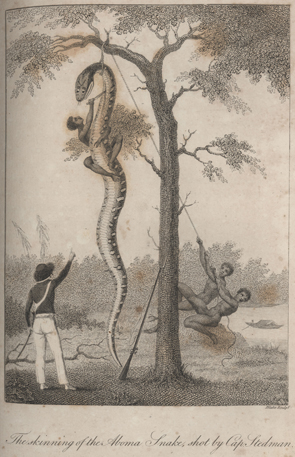
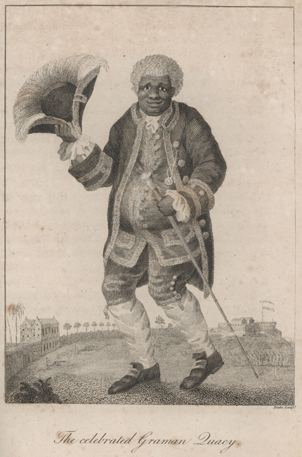
In the second place, the print comes not “from the Italian edition of Stedman’s ‘Narrative’” of Milan, 1818, with small octavo plates, but from an entirely separate work in folio, as Brandeis brilliantly discovered. The crucial clue is “Bramati,”There were three Bramati brothers, all engravers: Giuseppe (1795-1871), Antonio (1799-1875), and Luigi (1801-60) (Dizionario Biografico degli Italiani, vol. 13 [1971]). Giuseppe is the engraver of the Ferrario plates. whose name appears below the right corner of the design and in the embossing. The surrealistic scene comes from an enormous and enormously complicated compilation in seventeen folio volumes by Giulio Ferrario, which was published simultaneously in Italian and French editions, sometimes mixed together, such as the sets in the British Library and the Fisher Rare Book Library of the University of Toronto. The French version is called
Le costume ancien et moderne ou histoire du gouvernement, de la milice, de la religion, des arts, sciences et usages de tous les peuples anciens et modernes, d’après les monumens de l’antiquité et accompagné de dessins analogues au sujet par le docteur Jules Ferrario (Milan: De l'imprimerie de l'éditeur, 1817-26).
The Italian version is entitled
Il costume antico e moderno, o, storia del governo, della milizia, della religione, delle arti, scienze ed usanze di tutti i popoli antichi e moderni provata coi monumenti dell’antichità e rappresentata cogli analoghi disegni dal dottor Giulio Ferrario.
It was originally issued in 143 weekly installments, with over 1500 folio prints sold both plain and colored. There were later editions in Florence (26 8º vols., 1823-28), Naples (20 vols., 17 cm., 1831-42), Livorno (100 12º vols., 1830), and Turin (26 vols., 22 cm., 1834). Sometimes sets were sold, or at least survive, with only a single continent or even a single country. The portions devoted to the Americas are in vol. 7 (1820), with 87 prints (called America vol. 1), and vol. 8 (1821), with 80 prints (called America vol. 2, and on the half-title page Costumes de tous les peuples de l’Amérique seconde partie Amérique méridionale).
Elaborate efforts were made by Ferrario to ensure authenticity. The half-titles are stamped with the signature of “Giulio Ferrario,” and each print is embossed with a very small circle labeled Bramati, “costume antico e moderno,” presumably to frustrate forgers and imitators in the absence of international copyright. After all, Bramati was borrowing Stedman’s images without notice. When Laurence Sterne wanted to guarantee the authenticity of the authorized editions of Tristram Shandy, he signed each copy himself. This was much more time-consuming than stamping and embossing, and it could not be delegated to a mechanic—but on the other hand, Sterne was signing only one leaf per volume, whereas the Bramati embossing appears eighty times in the second volume of Ferrario’s America.
The engraving and coloring of the Bramati prints are professionally skillful. Most of the scenes are landscape dimensions and printed sideways. There are at least four plates derived from Blake’s plates in Stedman.The model for the Ferrario prints cannot be “the Italian edition [1818] of Stedman’s ‘Narrative,’” as the Swann catalogue suggests, for the Ferrario prints copy Stedman pls. 7-8, 19, 32, 35, 49, 53, 68, 71, and 76, and of these only pls. 7, 19, 35, 49, 68, and 76 appear in the Milan 1818 edition; pls. 8, 32, 53, and 71 echoed in Ferrario are not in the Milan edition. Indeed, most of the information in the section of Ferrario’s text “de la Guyanne” seems to be derived from Stedman, “traduction Italienne” (8: 406). For instance, there is an account of “le fameux Graman-Quacy” “avec le bel habit et la médaille d’or dont le Prince d’Orange lui fit présent … avec sa tête chauve et son habillement écarlate et bleu, galonné en or, tel qu’on le voit ici à la planche 59” (8: 406). And the young 22' boa snake, which was still alive when it was hung up, is described in the text: “voyez la planche ci dessus” (8: 409). The four Ferrario plates derived from Blake’s represent
Pl. 59 (see illus. 1): “Graman Quacy etc.,” signed “Bramati f.” at bottom right, “Bramati fec” at bottom left;
Pl. 62 (see illus. 4): “Planteurs de Surinam,” signed “G. Bramati dis. e inc.” at bottom left, “D. K. Bonatti l’A.T.” at bottom right;
Pl. 63 (see illus. 10): “Nègres sous un bon maître,” “G. Bramati dis”, “D. K. Bonatti l’A.T.”;
Pl. 65 (see illus. 12): “Chasseurs Négres [sic] affranchis à la poursuite des rebelles,” signed as in pl. 63.
The anomaly of the celebrated Graman Quacy calmly gazing at the viewer rather than watching the sensational scene behind him is explained by the fact that in the original he was not even in the same volume as the aboma snake—besides, the important feature in Le costume ancien et moderne was not officially what they did but what they wore or, in the case of the slaves and the snake, what they didn’t wear. In fact, however, the text does not focus exclusively or even very extensively on costume, and some of the scenes depicted are merely landscapes. Ferrario might have appropriately adopted Stedman’s subtitle, Elucidating the History of That Country, and Describing Its Productions, viz. Quadrupedes, Birds, Fishes, Reptiles, Trees, Shrubs, Fruits, & Roots; with an Account of the Indians of Guiana, & Negroes of Guinea … Illustrated with … Elegant Engravings.
There are significant differences between Blake’s engravings of “The Celebrated Graman Quacy” (illus. 3) and “The Skinning of the Aboma Snake” (illus. 2) and Bramati’s print of “Graman Quacy etc.” (illus. 1). For one thing, Bramati’s hunter, presumably Stedman himself, has picked up his gun from where he had left it carelessly leaning against the tree, put shoes on (Stedman customarily went barefoot), and turned round, so that we can see the powder horn slung across his chest. He has also slung on his sword, which he may have been holding in his left hand in Blake’s plate. The two naked slaves at the foot of the tree have been joined rather awkwardly by a third heaving on the snake-line with his back to the tree. The tree has gained a good deal of foliage, the little boat and the water on which it floats are gone, the serpent has lost his spots, and his tongue, so ominously flickering in Blake’s version, is scarcely visible in Bramati’s.
The celebrated Graman Quacy has been altered even more. His silver-headed walking stick has been moved from his left hand to his right, his extravagant hat is tucked under his right arm rather than flourished in his right hand, his metal shoe buckles are barely visible, and he is standing stolidly rather than walking with a fearful and ingratiating expression. More strikingly, his background has lost its fortress at the right and the house and tree plantation at the left. The “poppy field” at which Quacy points in Ferrario (but not in Stedman) is the Quessia amara, whose therapeutic benefits he pointed out to Europeans and which was therefore named after him. To unite the two quite disparate scenes, Bramati has extended Quacy’s foreground across that of Stedman and his aboma snake.
The sensational snake and Blake’s busy background have been simplified by Bramati to emphasize the costumes, or the lack of them. Bramati’s four slaves and the snake appear en déshabillé, Stedman’s shirt and Quacy’s nether garment and part of his extravagant hat are dark pink in the Fisher copy, Quacy’s coat is dark blue, the blossoms are touched with red, and the serpent is pale green. Some copies of the first edition of Stedman’s Narrative (1796) were commercially colored, but it seems unlikely that the copy of Stedman that Bramati copied was colored—or that his colorists cared if it was.
Blake, of course, was a professional artist and Stedman was only an enthusiastic amateur. Stedman’s designs do not survive, but it is generally assumed that Blake tidied them up and, probably inadvertently, Europeanized them. Blake had never seen Surinam or an aboma snake, and the poses and features of the individuals are likely to have been classicized, especially in the slaves struggling to hoist up the snake. Blake and Stedman would doubtless have been as astonished as Bob Brandeis and I were to see the sensational or naturalistic scenes of Stedman’s Narrative converted to costume fodder.
Graman (Great Man) Quacy was a well-known figure in Surinam who was crucially helpful to Stedman in tracing the “Revolted Negroes” to their jungle fastnesses. Quacy’s right ear was cut off by an Indian chief who was betrayed by him—and in Stedman’s portrait his right ear is not visible. Stedman wrote that Quacy “came to shew me his fine coat, gold medal, &c. which he had received as a present from the Prince of Orange, in Holland.”Stedman, Narrative … (London: J. Johnson, 1796) 2: 346. Presumably the elegant and odd European clothes and medal that Quacy is wearing are from the Prince of Orange. In their edition of Stedman, Richard and Sally Price speculate that the prevalence today of the name Quacy in Surinam and the West Indies may be due to the notoriety of Graman Quacy. However, this is probably not the case. Many years ago, when our daughter Julia took us to a concert by the extraordinary West Indian poet and singer Linton Quacy Johnson, I sent him a note backstage remarking on the speculation of the Prices. Six months later he very kindly replied, suggesting that perhaps the Prices were unaware that in the part of Africa from which his people had come, “Quacy” means “Sunday,” and that children born on Sunday are likely to be named Quacy.According to Wikipedia (Akan names), among the Akan people of Ghana and the Ivory Coast, children are frequently named after days of the week, such as “Kwesi” for Sunday.

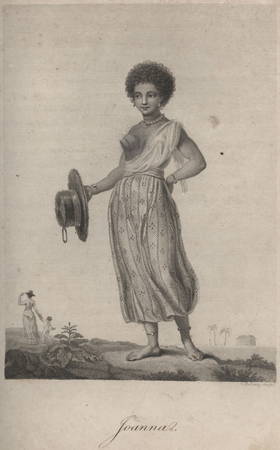
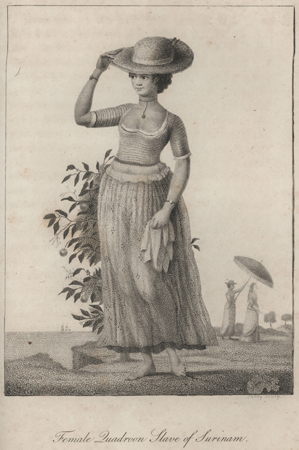
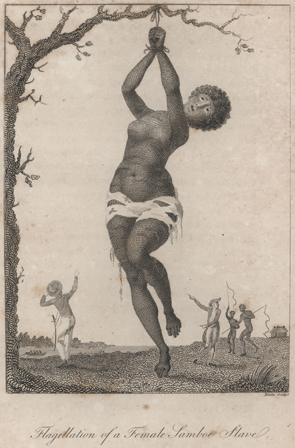
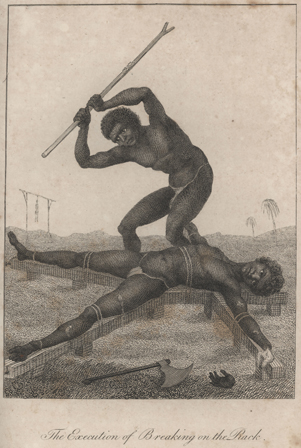
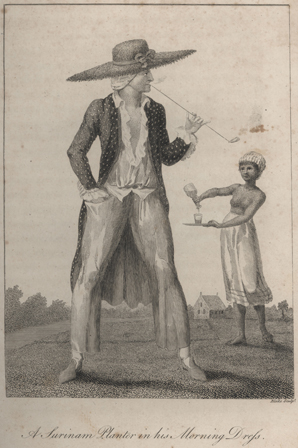
Ferrario pl. 63, “Nègres sous un bon maître” (illus. 10), is copied from Blake’s “Family of Negro Slaves from Loango” (illus. 11), reversed, with a reclining nude added in the background at left and a precipitous cliff at right in order to convert the portrait shape to landscape format. The woman is more European in Ferrario, her clothes are the same pattern in Blake but the skirt is blue and the top white in Ferrario, her pipe has much more smoke, the toddler is between the adults, and the Ferrario man looks directly at the woman. The scene is described in Ferrario 8: 433. Ferrario says little of bad slave-masters and does not reproduce Blake’s “A Negro Hung Alive by the Ribs to a Gallows,” Stedman pl. 11.
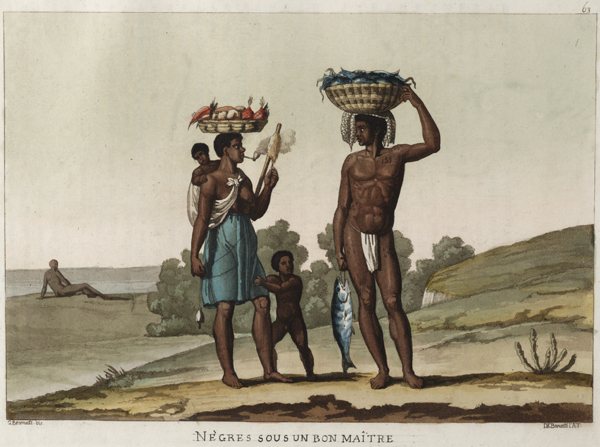
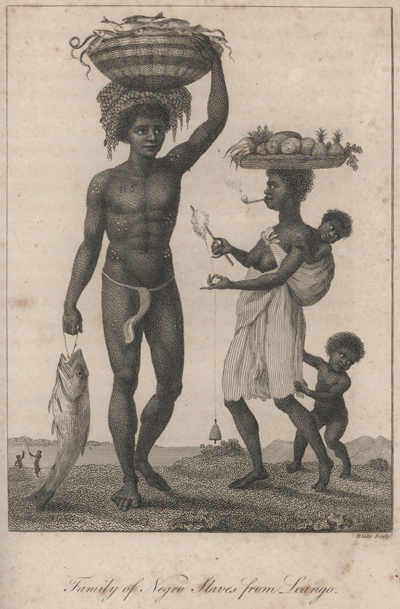
Pl. 65, “Chasseurs Négres [sic] affranchis à la poursuite des rebelles” (illus. 12), adapts Blake’s “A Coromantyn Free Negro, or Ranger, Armed” (illus. 13), with a bayonet added, plus soldiers coming up the crest of a hill to the right and omitting the background. The rebarbative individual to the left is apparently adapted from “A Rebel Negro Armed & on His Guard” (illus. 14), his head and left arm lowered; the ax, at his left side in Ferrario, is at his right side in Stedman. The middle thug is closely related to the one at the left, but the third has no precedent in Stedman. The skull and bone are from “A Negro Hung Alive by the Ribs to a Gallows.” The scene is described in Ferrario 8: 437. The single ranger is clad in a red bandanna and buff trousers in the Fisher copy.
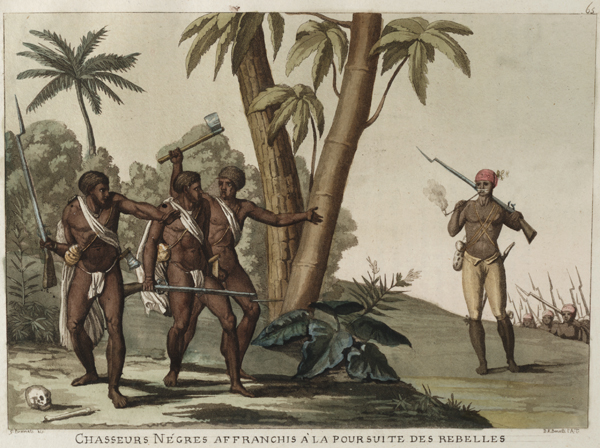
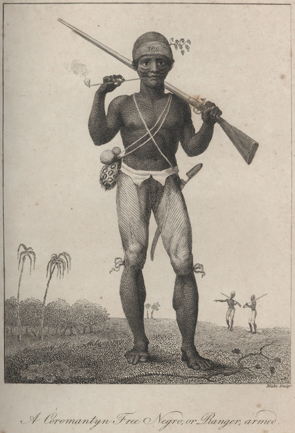
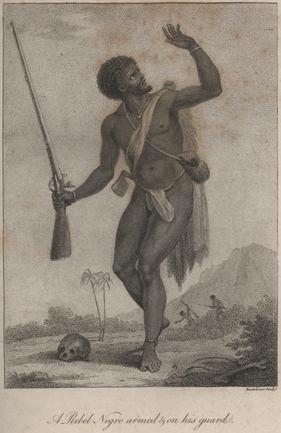
Other works of Blake’s time contain reproductions of his Stedman engravings:
1. John Pinkerton, ed., A General Collection of the Best and Most Interesting Voyages and Travels in All Parts of the World; Many of Which Are Now First Translated into English. Digested on a New Plan. By John Pinkerton … Illustrated with Plates, vol. 14 (London: Longman, Hurst, Rees, Orme, and Brown, and Cadell and Davies, 1813); at p. 257 is “The Skinning of the Aboma Snake”;
2. R. P. Forster, A Collection of the Most Celebrated Voyages & Travels, from the Discovery of America to the Present Time … Carefully Selected from Writers of Different Nations (Newcastle upon Tyne: Printed and published by Mackenzie and Dent, 1816), 8º, 80 parts in 4 vols., with 35 plates including Blake’s “Execution of a Negro in Surinam” (called “A Negro Hung Alive by the Ribs to a Gallows” in Stedman) and “The Skinning of the Boa Snake”;
3. Gottlieb Tobias Wilhelm, Unterhaltungen über den Menschen, 3 vols., 196 folding plates (Vienna, 1819), reproduces “A Female Negro Slave, with a Weight Chained to Her Ancle,” engraved by Bartolozzi, and the skinning of the aboma snake;
4. Anon., Travels in South America (Dublin: John Jones, 1824), woodcuts of “The Mecoo & Kishee Kishee Monkeys” and “The Skinning of the Aboma Snake.”
Blake’s father and brother kept a hosiery and haberdashery shop over which he was born and where he lived for at least the first fourteen years of his life, and he would have been familiar with the ambitions and vagaries of sartorial fashion. As a professional engraver, he made prints such as those for Stedman that incidentally represented the costumes of Australia, England, France, Greece (ancient), the Holy Land, Italy (Roman and Renaissance), the South Pacific, Spain, and Surinam. However, the only explicit fashion plates he made were the two that represented “The Morning Amusements of Her Royal Highness the Princess Royal & Her 4 Sisters” and “A Lady in the Full Dress, & Another in the Most Fashionable Undress Now Worn” for the Ladies New and Polite Pocket Memorandum Book for 1783 (1782).
The only other engravings by Blake that are known to have been copied in Blake’s time outside Britain were in Lavater, Aphorisms (Dublin, 1790) and the fourth edition (Boston and Worcester [Massachusetts], 1790), William Hayley, The Life of William Cowper (New York, 1803), copying Blake’s plates in the London edition of that year, and Marie Vollstonecraft, Marie et Caroline (Paris, 1799), copying Blake’s engravings after his own designs for Mary Wollstonecraft’s Original Stories (1791, 1796).